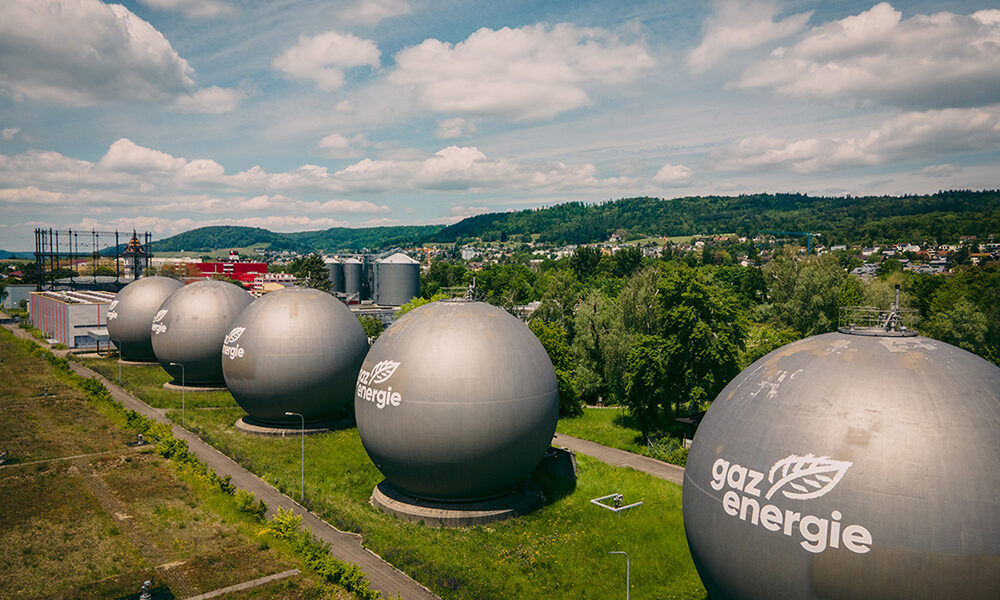In 2021 Energy One Belgium was contacted by MET Germany Holding GmbH, who had acquired two natural gas storage sites in Germany: a participation in the Etzel gas storage site (which is managed by Uniper), and full ownership of the Reckrod natural gas storage site. They had created a new legal entity, MET Speicher GmbH, to act as the Storage System Operator (SSO) for these storages.
As an SSO, MET Speicher is responsible for the management of in- and outflows in these underground gas storage sites. This means they interact with the TSOs for the areas their storages operate in, and also with the customers and counterparties that want to use these gas storage sites.
Developing the Storage Management Application
MET Speicher was newly formed, and as such had no ‘legacy’ IT infrastructure, allowing them to start with a ‘clean slate’ and select a mix of best-in-class solutions. One of the main systems needed was a reliable and future-proof IT solution to handle the daily management of the gas storage sites, including market communication, nomination, matching and balancing.
Their colleagues at MET International were already using Energy One solutions to balance their natural gas portfolio across Europe. Through an introduction, stakeholders at Energy One and MET Speicher discussed the possibility of developing a Storage Management Application (SMA) based on the same principles and user interface.
These discussions moved gradually from ideas to a tangible feature set, based on which we defined the project scope, roadmap and estimates of resources and costs required to build this.
Meanwhile, our project team was in the later stages of developing another custom solution; an asset management solution for a power plant of a large industrial customer, which you can read more about in this blog. The SMA was going to be built using the UI/UX and design philosophy used in that custom project.
This meant it was clear how to tackle MET Speicher’s request based on our dedicated expertise within the ‘custom project’ team. The kick-off for development was in April 2021 and the solution was up and running by mid-September 2021! Quite an astonishing feat by Energy One’s team.
When talking about the storage management application and other custom solutions we developed, our Head of Product comments:
“The common denominator of our custom solutions is that these manage the market communication and nomination/balancing of an asset for a client. The asset doesn’t really matter ; it could be a power plant, a gas storage site, an offshore gas grid or a battery energy storage system (BESS).”
Thomas Van Buggenhout – Head of Product at Energy One Europe
What does the SMA do?
In a nutshell: Our solution allows the client to efficiently handle market communication, matching and nominations of the in- and outflows of the natural gas storage sites of Etzel and Reckrod in Germany.
This includes:
- Calculating hourly storage capacity, maximum injection and withdrawal volumes
- Market Communication with the TSOs and gas shippers
- Matching nomination requests from shippers and incoming TSO confirmations
- Reporting, audit logs and error notifications
- Automation via event- or time-driven checks and workflows
- User management and permissions
- Master data and contract management
In the next paragraphs, we showcase the modules that make up the storage management application, and go through the features a bit more in-depth.
User Interface and main dashboard
We aim to keep the same design language across multiple solutions, resulting in a consistent user experience when switching between solutions.
As you can see below, the main section displays a sidebar on the left with different icons that people can access to enter each functional module. The top bar shows a date picker on the left, where users can select the day they want to view data for.
The top bar also shows an easy to understand ‘matching status’, using a traffic light system. Green lights show matched positions and red lights indicate mismatches for the selected day (within-day) as well as the day-ahead positions.
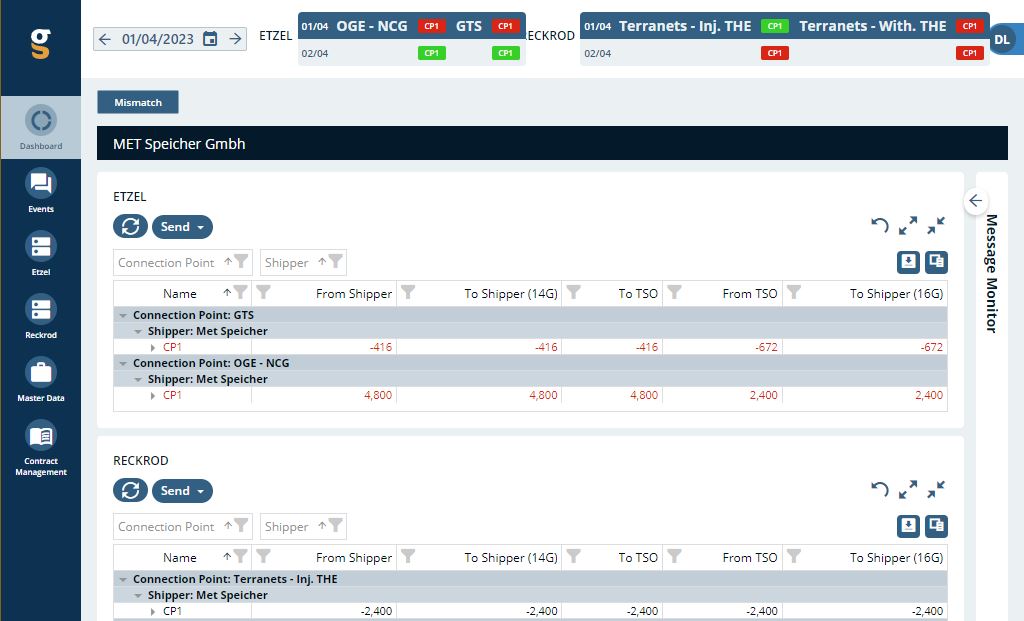
The dashboard screen shown above offers an overview of each storage’s connection points, the shippers and their counterparties. It shows incoming shipper nomination requests for injection or withdrawal of gas, which are then sent to the TSO.
When the TSO confirms these nomination requests with the same volume, then there’s a matched position; if the numbers deviate between shipper and TSO there is a mismatch; as you can see in the examples above. For our (fictitious) scenario, the Reckrod Storage is matched, while two positions on Etzel show a mismatch between the values sent to the TSO by the shipper and the values received back from the TSO.
Operators can easily drill down on each connection point and counterparty from daily to hourly level. They can manually edit and trigger additional messages to the shipper and TSO to get to a matched position.
Several quality-of-life features are present as well, allowing users to easily:
- export the values on a specific screen to excel or CSV
- choose which columns are shown
- manually edit hourly or daily values
- trigger new messages to the TSO (DelOrd, DelRes, NomRes)
Capacity overview and calculations of capacities
The ‘Capacity’ screen shows an overview of capacity for each storage location on the site. Users can easily see nominated volumes, nomination responses, maximum allowed injection volume, maximum allowed withdrawal volume and much more on an hourly or daily basis.
The capacities for a storage site can either be imported from another system or are calculated by the solution. For Etzel storage site, the SSO (Met Speicher) gets the allowed injection and withdrawal from the technical SSO (Uniper) and our system displays these values.
For the Reckrod site, the application uses parameters set in different Master Data modules, such as ‘Technical Limits’ and ‘Commercial Limits’. Based on the current storage level and these limits, the solution will calculate the Working Gas Volume, as well as allowed injection and withdrawal volumes for every hour of the day.

Diving into the ‘Details’ tab of the capacity screen, you can see a detailed overview of the storage level for the selected day and the fourteen days leading up to it.
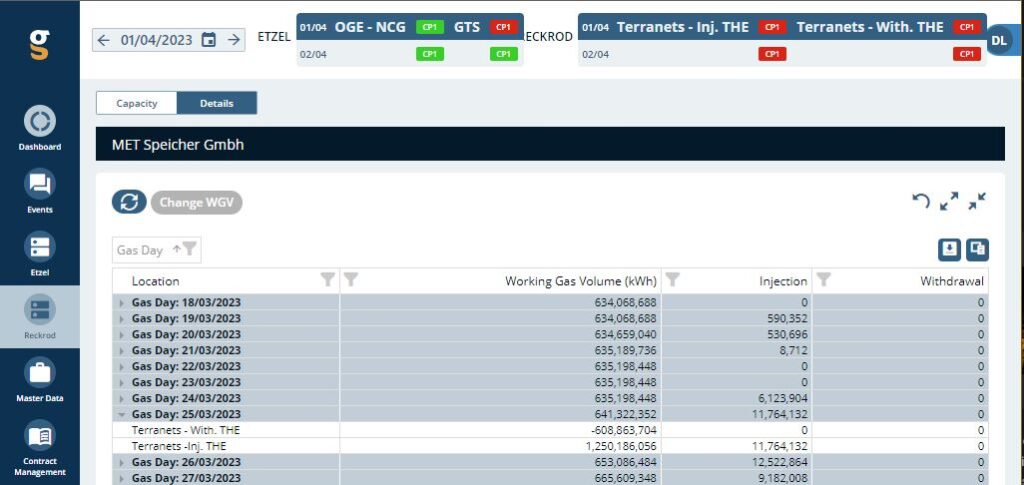
Events, messages and communication center
Our solution is partly event-driven; each change is captured and logged as an event. This is useful for auditing purposes as well as for automation, since it can be used to trigger event-based workflows.
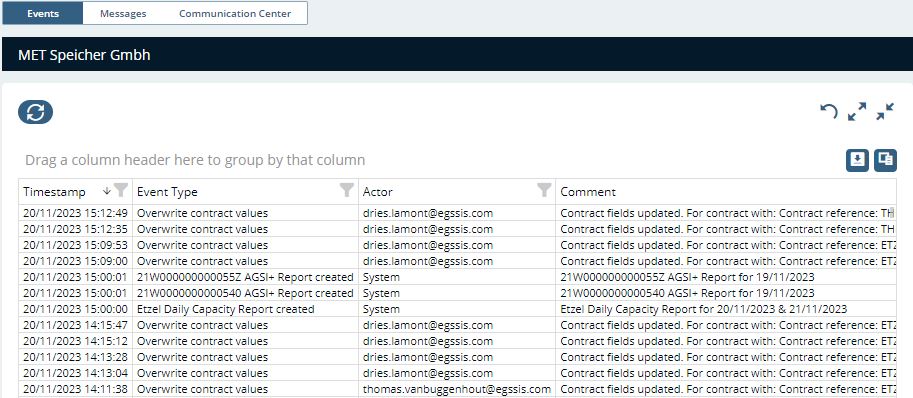
The messages ‘tab’ shows a detailed overview of all incoming and outgoing messages.
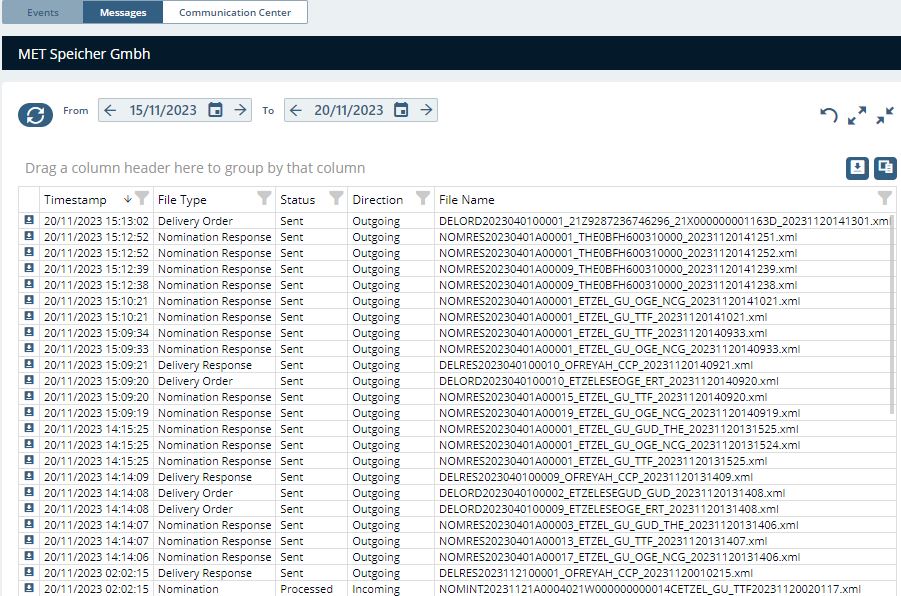
A ‘message monitor’ widget is also embedded on the side when operators are working in the dashboard menu, allowing them to easily look at all messaging to and from the TSOs and counterparties while they’re in another screen.
The communication center allows managers to trigger event- or time-based alerts, warnings and more, with notifications sent via email, phone, SMS or a service bus connection to another IT System.

Alerts and pop-ups in the Storage Management application can also be configured. Here’s an example of how this looks for a mismatch:

Conclusion
Once again, the teams at Energy One have used their decades of experience in energy markets to plan, develop and test a new custom solution in a short timeframe, thanks to the agile way our development teams operate.
Based on our experience with developing the Storage Management Application, we can take the same principles and build similar solutions for any Storage System Operator in Europe. Our sales team is happy to talk and demonstrate our capabilities if you are interested in learning more. Reach out if your gas storage could use a new solution that will save you time and minimize the risk of human error.

